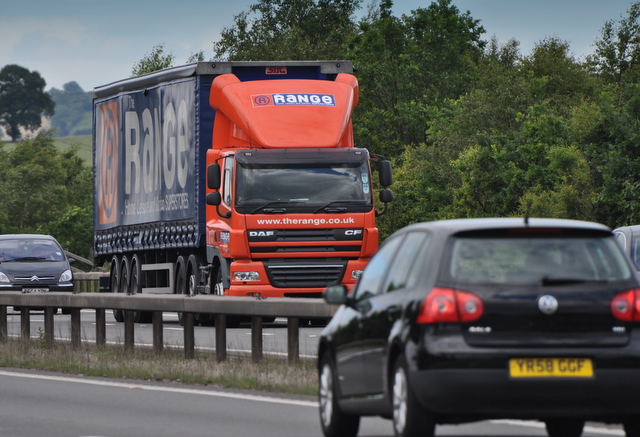
Longer lorries will be introduced to Great Britain’s (GB’s) roads to support the government’s priority to grow the economy, boost productivity, slash road emissions and support supply chains.
Legislation will be laid today (10 May 2023) to safely roll out the vehicles on roads from 31 May. The longer lorries will be able to transport fast-moving consumer goods and retail products, as well as waste packaging, parcels and pallets.
These new lorries will move the same volume of goods, but will use 8% fewer journeys than current trailers. This will generate an expected £1.4 billion in economic benefits and take one standard-size trailer off the road for every 12 trips.
As part of efforts to grow the economy and cut emissions, government is changing regulations to allow longer trailers on GB roads, which it estimates will save 70,000 tonnes of carbon dioxide from being released into the atmosphere.
These longer trailers, known as longer semi-trailers (LST) measure up to 2.05 metres longer than a standard semi-trailer and can be towed by a lorry.
The move follows an 11-year trial to ensure LSTs are used safely on roads, and operators will be encouraged to put extra safety checks and training in place. The trial demonstrated that LSTs were involved in around 61% fewer personal injury collisions than conventional lorries.
Roads Minister Richard Holden said:
Everyone around the country depends on our haulage sector for their everyday needs – from loo rolls to sausage rolls – and a strong, resilient supply chain is key to the government’s priority to grow the economy.
These new longer lorries will make a big difference for British businesses like Greggs, who will see 15% more baked goods delivered, from tasty pastries to the nation’s much-loved sausage rolls.
It’s fantastic to see this change for our supply chain come into law, resulting in a near £1.4 billion boost to the haulage industry and driving economic growth. Let the good times roll as we reduce congestion, lower emissions and enhance the safety of British roads.
Vehicles which use LSTs will be subject to the same 44 tonne weight limit as those using standard trailers. These new vehicles are also expected to cause less wear on the roads than conventional lorries due to the type of steering axle used.
Operators will be legally required to ensure appropriate route plans and risk assessments are made to take the unique specifications of LSTs into account.
In addition to these new legal requirements, operators will also be expected to put in place extra safety checks including driver training and scheduling, record keeping, training for transport managers and key staff, and loading of LSTs.
It is expected that LSTs will create almost £1.4 billion in net economic benefits by ensuring more goods are carried on fewer vehicles, supporting productivity and boosting the economy.
With over 300 companies in the UK having already taken part in the trial, and almost 3,000 on the road, some of the biggest brands will be rolling out the extended use of these longer semi-trailers including:
- Greggs
- Morrisons
- Stobart
- Royal Mail
- Argos
Gavin Kirk, Supply Chain Director at Greggs, said
We welcome the introduction of LSTs into general use. Since 2013, Greggs has been operating LSTs from our National Distribution Centre in Newcastle. We were early adopters of the trial as we saw significant efficiency benefits from the additional 15% capacity that they afforded us.
We have converted 20% of our trailer fleet to LSTs, which was the maximum allowable under the trial, and these complement our fleet of double-deck trailers. Our drivers undertook additional training to use these trailers and we have monitored accidents, finding that they are as safe as our standard fleet.
Due to the increased capacity, we have reduced our annual kilometer (km) travel by 540,000 km, and saved 410 tonnes of carbon per year from LSTs. This supports our wider ESG agenda, the Greggs Pledge.
The trial revealed the important environmental benefits associated with the introduction of LSTs, including a considerable reduction of 70,000 tonnes of CO2 and 97 tonnes of NOx over the trial.
The average CO2 reduction across the lifetime of the trial is similar to the amount of CO2 captured by roughly 11,600 acres of forest per year.
The savings in NOx emissions averages to the entire annual NOx emissions of around 2,000 diesel cars per year.
Introducing LSTs is an important, easy and affordable measure to continue to reduce CO2 emissions from the haulage industry without significant technological and infrastructure development, as the government continues to work closely with the sector to ensure all new heavy goods vehicles (HGVs) are net-zero by 2040.
The move is part of the government’s comprehensive 33 actions to address the shortage of HGV drivers and boost recruitment and retention.
Government’s 33 actions to support Britain’s haulage sector include:
- £52.5 million will be given to improve roadside facilities for lorry drivers
- making 11,000 HGV driver training places available through skills bootcamps
- boosting the number of HGV driver tests
- launching our Future of Freight plan to encourage millions of people to kickstart an exciting career in logistics
As a result, new HGV drivers are taking and passing their driving test in record numbers.
Between March 2022 and May 2022, the Driver and Vehicle Standards Agency (DVSA) carried out 29,384 HGV tests, which is 54% more than the same period in 2019.
Chris Yarsley, Senior Policy Manager at Logistics UK said:
The introduction of longer semi-trailers (LSTs) into general service will increase the scope and scale of the goods which our industry is able to transport, increasing efficiencies and reducing the environmental impact of delivering for the UK’s economy.
Over the past few years of the trial, our members have proved that LSTs provide operators with a cost-efficient, environmentally prudent alternative to conventional vehicles and our members remain committed to rolling them out across the wider industry as soon as possible. Photo by John Carver, Wikimedia commons.




































